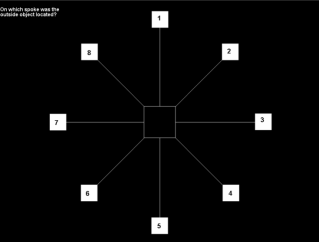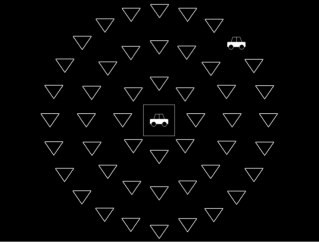Useful Field of View Test: UFOV
The UFOV is a test that assesses parallel attentional processing. It has been shown to help predict crash risk in older drivers. It is a computer administered and scored test. The test includes three subsets, which measures the ability to perform a central visual  identification task, to divide attention between central and peripheral stimuli and to select peripheral stimuli from among distracters. It has been defined as the area from which one can extract visual information in a brief glance without head or eye movement. The limits of this area are reduced by poor vision, difficulty dividing attention and/or ignoring distraction, and slower processing ability. The area from which a driver can extract visual information at a quick glance declines, as people grow older as does the time it takes to process that information. UFOV researchers have defined cognitive impairment as a 40% reduction in the Useful Field of View, and it is the point at which the risk of crashing increases significantly.
identification task, to divide attention between central and peripheral stimuli and to select peripheral stimuli from among distracters. It has been defined as the area from which one can extract visual information in a brief glance without head or eye movement. The limits of this area are reduced by poor vision, difficulty dividing attention and/or ignoring distraction, and slower processing ability. The area from which a driver can extract visual information at a quick glance declines, as people grow older as does the time it takes to process that information. UFOV researchers have defined cognitive impairment as a 40% reduction in the Useful Field of View, and it is the point at which the risk of crashing increases significantly.
Target objects are presented on the computer monitor. The information presented from simple to complex and presentation time between presentations of the two stimuli varies depending on the participant’s pattern of performance.
UFOV is helpful in our practice in evaluating patients at the mild visual loss levels (approximately 20/20 to 20/100) and may not help us patients with more significant loss (approximately 20/120 to 20/200 or less). It is very helpful in the aged driver, dementia issues, cerebral palsy and traumatic brain injury. It may help us determine which seniors have potential for a restricted license to drive at a mildly impaired visual acuity level. A poor score alerts us to a patient that appears to have the skills to drive, but in fact may have cognitive and/or processing problems.
Part 1: The participant identifies a target presented in the center of the computer screen for varying lengths of time.

Part 2: The participant identifies a target object as before but must also localize a simultaneously presented target object displayed in the periphery of the screen.

Part 3: Part 3 is similar to part 2 except that the target objects displayed in the periphery is embedded in distracters that make the task more difficult.

Reference List of Publications Related to UFOV
